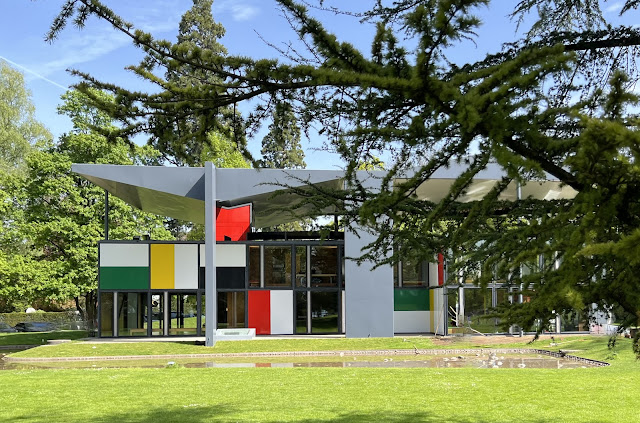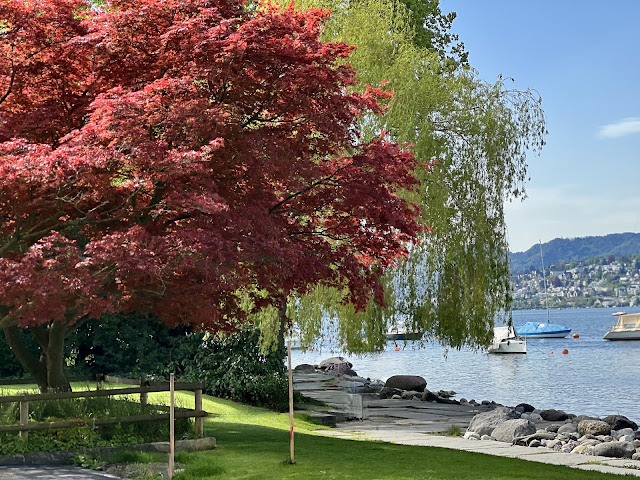Welcome back to my series "is Zurich like every European city?" Of course the unavoidable museum is marked on the “Itchy Feet” map:
When you hear the word “museum,” what comes to mind? A grand, time-honored building housing "old things" in glass cases? Honestly, that’s what I think. Many cities and museums fit this image. However, today, I’d like to introduce you to a museum that offers something a bit different.
A Masterpiece in the Making: Inside Le Corbusier's Final Vision
Have you ever heard of Charles-Édouard Jeanneret-Gris? No? Me neither - until I learned he’s better known as Le Corbusier. Sound familiar now? That’s because he’s one of the most influential architects of the 20th century. Beyond just form and structure, Le Corbusier viewed color as a vital design element. His “Polychromie Architecturale,” a harmonious color palette he developed, is not only a tool for architecture but also a piece of art in itself.
Seventeen buildings across seven countries have been designated World Heritage Sites under the title “The Architectural Work of Le Corbusier.”
Le Corbusier wasn’t just an architect. He was an urban planner, painter, draughtsman, sculptor, and furniture designer, leaving an indelible mark on Switzerland and its neighbors. One of his last masterpieces, the Pavillon Le Corbusier, is nestled on the edge of Zurich’s Chinese Garden.
Completed just weeks before Le Corbusier’s unexpected death, the Pavillon was the brainchild of Heidi Weber, who was both the financier and the patron behind the project. She envisioned a space where the public could engage with Le Corbusier’s artistic legacy. The pavilion, designed by the artist himself, functioned as a private museum from 1967 until 2014.
Since 2019, the Museum für Gestaltung Zürich has managed and opened the pavilion to the public during the summer months.
By summer they mean starting in late April. So in that sense, this post comes too early, as I was unable to visit the pavilion.
A Gift of Tranquility: Exploring Zurich's Authentic Chinese Garden
The Chinese Garden was a gift from Zurich’s twin city of Kunming, a symbol of gratitude for help with the city’s water supply. This serene garden, with its pond, small island, and a palace along its banks, ranks among the highest-tier temple gardens outside of China.
The garden's design centers around the theme of "Three Friends in Winter"—pine, bamboo, and winter plum—symbols of strength and resilience in Chinese culture, which thrive through the coldest seasons.
While many European cities boast botanical gardens or spaces with Asian influences, authentic, architect-designed Chinese gardens are rare. Only a handful of countries, including Germany, Sweden, and Ireland, house such treasures. And then there's ours!
The Absurdity of Motion: Jean Tinguely's Kinetic Sculpture of Invention
As you stroll further into the park, you’ll encounter something entirely different—a piece by Jean Tinguely, the kinetic sculpture Heureka. Made from iron rods, steel wheels, metal pans, and pipes, this sculpture, originally created for the 1964 National Exhibition in Lausanne, runs three times a day from April to mid-October. (Watch the video here.)
The title, "Heureka" (Greek for "I have found it!"), is intentionally ironic. Tinguely’s “idle machines” serve as a commentary on the absurdity of consumer and industrial society, where constant motion leads nowhere meaningful.










The museum reminds me of Piet Mondrian. I hope you're able to go inside the museum another time. The comic made me giggle. The Chinese Garden looks lovely and I wouldn't doubt the pictures do not do justice to it's beauty. The boats out on the water look peaceful and pavilion serene.
ReplyDeleteI love the contrast between the vibrant museum to the tranquil gardens. They almost don't fit together. It would be interesting to spend some time there exploring.
ReplyDeleteWhat a beautiful city and tour you gave! It looks so peaceful strolling through.
ReplyDeleteI like the concept of 3 friends in winter. I wasn't crazy about the museum, though. I don't know, I guess it has similarities, but it sounds it has some compelling unique features, too.
ReplyDeleteI love how you brought together art, architecture, nature, and even a bit of playful absurdity with Tinguely’s piece. The Chinese Garden sounds like a dream escape—yes, I’d absolutely love to spend time there, soaking in the peace and poetry.
ReplyDeleteI would love to visit the Chinese garden .It looks just so serene and pretty.Plus the city map is superb.Cities need to get rid of those drug dealer parks!
ReplyDeleteI am in love with that Chinese garden!!
ReplyDeleteDonna: Click for my 2025 A-Z Blog
Thanks for guided tour, Tamara. I love the Chinese garden, the pavillon and motion to nowhere sculpture. Such treasures in a city.
ReplyDelete